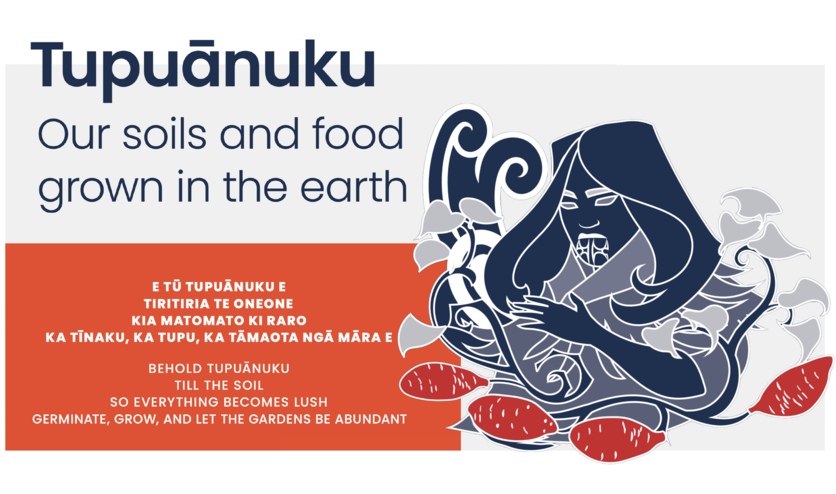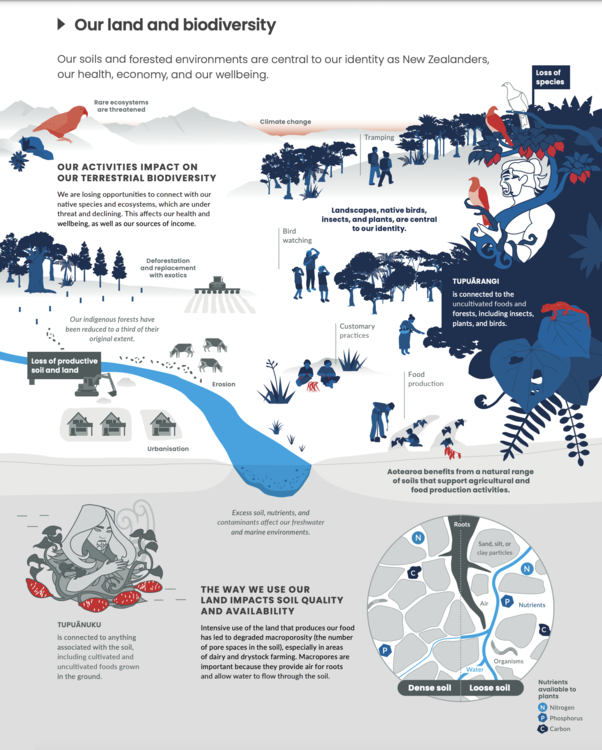Tupuānuku is a whetū in the Matariki cluster. It is the star connected to anything associated within the soil, including cultivated and uncultivated foods grown in the ground.
Aotearoa New Zealand’s Ministry for the Environment and Stats NZ have produced Environment Aotearoa 2022 as part of its environmental reporting series. Environment Aotearoa 2022 has a unique approach that uses Te Kāhui o Matariki as the guiding framework for the report. Learn more about this approach in the article Environment Aotearoa 2022 – introduction.
In Environment Aotearoa 2022, Tupuānuku represents soil quality – the health of our soils and the different ways in which this affects our wellbeing. Te taiao (the environment) is interconnected – when we put pressure on our soils, this affects other environmental domains including freshwater and marine environments.
Tupuānuku is comprised of two words: ‘tupu’ which can mean ‘new shoot’ or ‘to grow’, and ‘nuku’, an abbreviation of ‘Papatūānuku’ (Earth mother). Tupuānuku resides in the domain of Rongo-mā-Tāne, the atua of agriculture.
Environment Aotearoa 2022
Interwoven knowledge systems
The connections between soil and people are strong. Origin stories from around the world refer to humans as being formed from soil. In te ao Māori, Hineahuone was created from clay and her name means ‘earth-formed woman’. When we die, our bodies are returned to the soil.
When we examine our understanding of soils, there are numerous crossovers between mātauranga Māori and science.
Soils have whakapapa – they are formed and shaped by parent material (rocks, volcanic ash and sediments), climate, land formations and living things. Whakapapa and soil formation influence how we use the land. Knowing about the soils’ origins helps us choose the most sustainable locations to grow vegetables, plant vineyards, grow pasture grasses and build houses.
Soils have mauri – they are living ecosystems that sustain and support life. Soils are home to over 25% of the world’s biodiversity, which includes insects, earthworms, fungi and microorganisms. Soils are also key to sustaining human life. Caring for our soils helps to improve their mauri.
The state of Tupuānuku
The article Pōhutukawa – pressures on the environment outlines some of the issues that land use (how we’ve modified the whenua to suit our human needs) are having on te taiao. Many of these pressures directly affect soil quality. Soil scientists use a set of indicators when monitoring soil quality. The indicators measure important soil properties like porosity (spaces in the soil that allow air and water to circulate), carbon (organic matter) and nutrients like nitrogen and phosphorus that help plants grow.
Soil quality has remained much the same between the years 1994–2018 – there have been no overall improving or declining trends. Nearly half of all the sites where soil quality is measured were below the target range for porosity. Heavy machinery and large numbers of livestock per hectare can compact (squash) the soil. However, over the last few years, over 90% of the measured soils met target ranges for other soil quality indicators including carbon and pH.
Losses due to erosion and land fragmentation
Soils face pressure due to erosion and land fragmentation. Erosion is a widespread natural process in Aotearoa, partly due to high rainfall and the vulnerable, steep terrain. Humans have added to the problem by removing the trees from hilly areas to create pasture. Data from 2012 showed that an estimated 192 million tonnes of eroded soil entered our rivers each year. Erosion degrades freshwater and marine habitats and reduces the benefits that soils can provide.
Land fragmentation is another threat to our soils. Only 15% of the total land area of Aotearoa has highly productive soils. Our urban areas were often settled to make use of good soils, so when we expand to build roads or new housing, we remove this land from productive use. The area of highly productive land no longer available for crops and livestock increased by 54% in the period 2002–2019.
Why healthy soils matter
Research suggests that high-quality healthy soils are linked to healthier, more nutritious foods, which in turn help to create healthier people. Maintaining good soil quality is also good for our economy. In the year ended March 2020, agriculture and horticulture exports generated $40.7 billion in export revenue.
Tupuānuku reminds us that we need to look after soil. It is a special resource. If we pollute it or lose it, we cannot buy or make more.
Related content
Māori were the first soil scientists of Aotearoa.
The Hub has extensive resources on soil. Explore these curations:
- Soil – introduction (younger learners)
- Soil, farming and science – introduction (older learners)
- Land (collection)
The article Te ao Māori concepts within Kiwi Kai ❘ Ngā ariā o Te Ao Māori kei roto i te kēmu Kiwi Kai explores concepts such as mana atua, mauri and te mana o te taiao and actions we can take to support Papatūānuku.
The Science Learning Hub team has curated a collection of resources to support Matariki and Environment Aotearoa 2022. This collection provides additional context and pedagogical insights.
Oneone – soils is a collection that supports pilot-ready Agricultural and Horticultural Science 1.3 Demonstrate understanding of how soil properties are managed in a primary production system. – but it is also useful for anyone interested in soils and primary production.
Log in to make any of these collections part of your own private collection, just click on the copy icon. You can then add additional content and notes. share and collaborate with other and more.
Our land 2024 is part of the Ministry for the Environment and Stats NZ reporting series. The focus is on the impacts of land use. This article looks more closely at ao Māori perspectives of land and soil.
Activity idea
Learn about soil quality and soil properties by conducting a visual soil assessment (VSA). The activity involves digging up a 20 cm cube of soil to examine the soil structure and porosity and look for earthworms. This simplified VSA can be done at school or on a farm pasture.
Useful links
Stats NZ and the Ministry for the Environment report on different aspects of Aotearoa New Zealand’s environment every 6 months. Access their reports here.
Visit Stats NZ for more information on estimated long-term soil erosion and land fragmentation.
SINDIonline: Soil Quality Indicators is a web-based tool to help people interpret the quality or health of a soil sample. Developed by Manaaki Whenua Landcare Research, it uses the seven indicators mentioned in Environment Aotearoa 2022.
Acknowledgement
This resource has been produced in collaboration with the Ministry for the Environment and Stats NZ.



